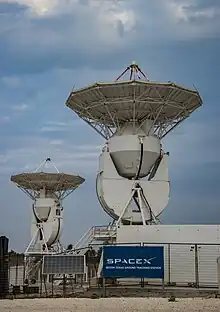STARGATE
STARGATE—Spacecraft Tracking and Astronomical Research into Gigahertz Astrophysical Transient Emission—is a radio-frequency (RF) technology facility under development next to the SpaceX Starbase in south Texas.

The facility is intended to provide students and faculty access to RF technologies widely used in spaceflight operations, and will include satellite and spacecraft tracking.
History
The Spacecraft Tracking and Astronomical Research into Gigahertz Astrophysical Transient Emission facility was proposed in 2012 by Fredrick (Rick) Jenet, director of the Center for Advanced Radio Astronomy (CARA) and an associate professor of physics and astronomy at the University of Texas-Brownsville. Initial funding included US$500,000 in seed money provided by the Greater Brownsville Incentives Corporation in October 2012, as part of a package to increase the likelihood of attracting SpaceX to build a launch site in the area.[1]
In 2014, following the announcement of the SpaceX private spaceport being built near Boca Chica Beach, the Brownsville Economic Development Council (BEDC) purchased several lots in Boca Chica Village totaling 2.3 acres (0.93 ha) approximately 2 miles (3.2 km) from the SpaceX launch site and renamed it as the STARGATE subdivision. The land is used for the STARGATE project including the construction of a 12,000 square feet (1,100 m2) tracking center.[2]
Construction bids for a dual-channel fiber optic link between UT Brownsville and the STARGATE/SpaceX sites at Boca Chica went out in early March 2015.[3]
In mid-2015, the University of Texas at Brownsville merged with another university to become the University of Texas Rio Grande Valley. STARGATE contracts and administration moved to the new university administrative structure.
Two 9 m (30 ft) S-band tracking station antennas from decommissioned Merritt Island Spaceflight Tracking and Data Network station were refurbished and installed at the site in 2016–2017.

Funding
As of March 2015, the grants to fund STARGATE have totaled approximately US$10.7 million, consisting of:
- US$4.4 million from the Texas Emerging Technology Fund
- US$4.6 million from the University of Texas System
- US$1.2 million from the US Economic Development Administration
- US$0.5 million from the Greater Brownsville Incentives Corporation.[3]
STARGATE was initially funded by US$500,000 in seed money provided by the Greater Brownsville Incentives Corporation in October 2012, which was intended to improve the likelihood that Brownsville would be successful in attracting SpaceX to build a launch site in the area.[1]
Further incentives were presented to SpaceX in September 2013 when the University of Texas System proposed that SpaceX partner with UT Brownsville's Center for Advanced Radio Astronomy in building and operating STARGATE.[4]
STARGATE received a US$1.2 million grant from the US Economic Development Administration in October 2014.[5]
Early in 2015, "the Brownsville Economic Development Council donated property at Boca Chica to the UT system for the STARGATE Technology Park."[3] The dollar value of the in-kind funding for the property was not released.
Technology
As of October 2014, STARGATE intends to develop new devices and new algorithms for tracking spacecraft, and intends to commercialize those technologies.[6]
STARGATE plans to "test and commercialize a new phased-array antenna system that will replace fixed satellite-dish tracking communication systems."[7]
See also
- European Space Tracking
- ISRO Telemetry, Tracking and Command Network
- NASA Deep Space Network
- Near Earth Network
- Space Network
- Merritt Island Spaceflight Tracking and Data Network station
- Starlink – a satellite constellation that provides both backhaul and direct internet service, and which utilizes phased-array antenna technology for the terrestrial transceivers
References
- Clark, Steve (2012-11-26). "'STARGATE' facility may be coming to Brownsville". The Monitor. Retrieved 2014-10-07.
- Perez-Treviño, Emma (2014-09-25). "SpaceX makes more moves". Valley Morning Star. Retrieved 2014-09-27.
- PEREZ-TREVIÑO, EMMA (2015-03-12). "Fiber optics to link SpaceX, UT". Brownsville Herald. Retrieved 15 March 2015.
- Armendariz, Jacqueline (2013-09-23). "UT System proposes research partnership with SpaceX in Brownsville". The Monitor. Retrieved 2014-10-07.
- "STARGATE to receive $1.2 million EDA grant". Brownsville Herald. 2014-10-06. Retrieved 2014-10-07.
-
"About STARGATE". UT Brownsville. University of Texas. 2014. Retrieved 2014-10-09.
STARGATE will develop new radio frequency based technologies. STARGATE has already identified specific, innovative devices and improved algorithms that will soon allow for the next generation of orbital communication systems. This new technology will be the first wave of inventions commercialized at STARGATE. ... STARGATE intends to: ... [p]ublish reports on commercialization successes and host showcase events for the public.
- SpaceX Breaks Ground on Launch Facility in Texas, September 2014.
External links
- STARGATE webpage, at UT Brownsville.
- Stargate 1: Rocket Science and the RGV, following inaugural STARGATE Talk, May 2015.
- UTRGV’s STARGATE Academy, July 2016.
- Two large satellite-tracking ground stations antennas to Boca Chica, July 2016.